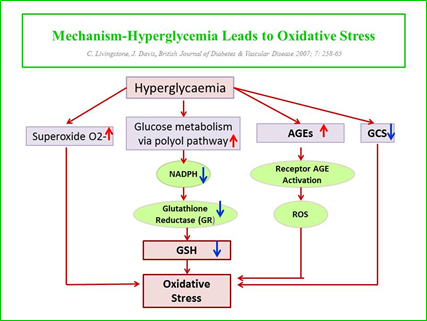British Journal of Diabetes & Vascular Disease 2007; 7: 258-65
Review: Targeting therapeutics against glutathione depletion in diabetes and its complications.
There are several mechanisms whereby hyperglycaemia may bring about oxidative stress via changes in glutathione metabolism (figure 3).22 Firstly, excessive glucose oxidation overloading the mitochondrial electron transport chain is thought to be the main source of O2 –(superoxide radical) putting demands upon the glutathione pool. Hyperglycaemia also results in increased flux through the polyol pathway causing NADPH depletion, impaired GR activity and a decrease in the GSH:GSSG ratio. There is increased formation of advanced glycation end-products which are known to bind to RAGE receptors thereby generating ROS and depleting glutathione.23,24 In vitro studies on cultured cells have demonstrated that exposure to high extracellular glucose concentrations leads to a decrease in intracellular glutathione levels proposed to result from reduced activity of GCS and enzymatic glycation.9,25,26 There is also decreased GPx activity, which is expected to increase oxidative stress. Hyperglycaemia does not require to be sustained in order to promote oxidative stress. Even brief hyperglycaemic episodes which occur during a glucose tolerance test or postprandially can decrease the antioxidant capacity of plasma in normal and diabetic subjects.27,28
Review: Targeting therapeutics against glutathione depletion in diabetes and its complications.
There are several mechanisms whereby hyperglycaemia may bring about oxidative stress via changes in glutathione metabolism (figure 3).22 Firstly, excessive glucose oxidation overloading the mitochondrial electron transport chain is thought to be the main source of O2 –(superoxide radical) putting demands upon the glutathione pool. Hyperglycaemia also results in increased flux through the polyol pathway causing NADPH depletion, impaired GR activity and a decrease in the GSH:GSSG ratio. There is increased formation of advanced glycation end-products which are known to bind to RAGE receptors thereby generating ROS and depleting glutathione.23,24 In vitro studies on cultured cells have demonstrated that exposure to high extracellular glucose concentrations leads to a decrease in intracellular glutathione levels proposed to result from reduced activity of GCS and enzymatic glycation.9,25,26 There is also decreased GPx activity, which is expected to increase oxidative stress. Hyperglycaemia does not require to be sustained in order to promote oxidative stress. Even brief hyperglycaemic episodes which occur during a glucose tolerance test or postprandially can decrease the antioxidant capacity of plasma in normal and diabetic subjects.27,28

HMS 90®
Contact Details
บริษัท อิมมูโนไทย จำกัด245/4 ถ.สุขุมวิท 21 (อโศก) แขวงคลองเตยเหนือ เขตวัฒนา กรุงเทพฯ 10110092-696-6925info@immunothai.co.th

